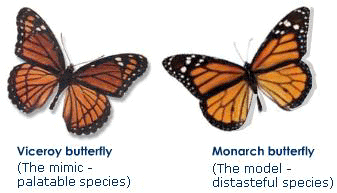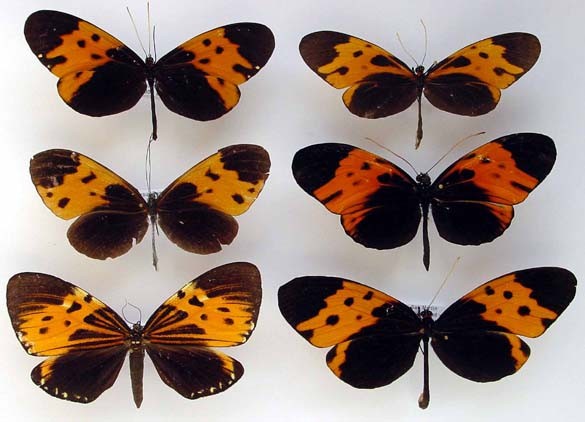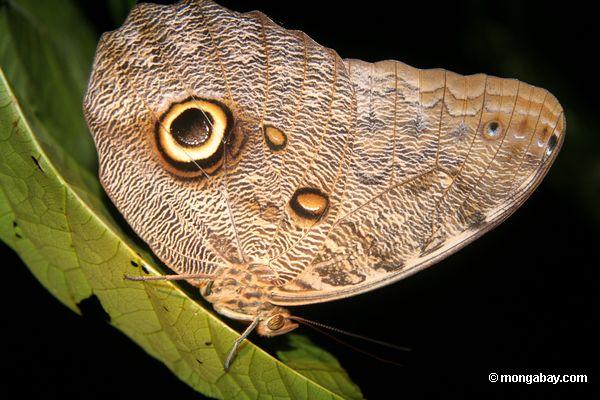Introduction
For evolutionary biologists mimicry and deception in animals has been of great interest. This is because the evolution and genetic background of the technique and or physiology is very complex (Searcy and Nowicki, 2005).Most animals use some form of deception. Birds can display exaggerated body movements or singing to attract a mate(Searcy and Nowicki, 2005). Humans also use deceit, for example in any typical business presentation. Mimicry and Deception are both physiological or behavioral adaptations of an animal or plant, in order to survive and reproduce.
Mimicry
There are 3 types of mimicry:
The first type is Batesian mimicry, which is when a defenseless prey species mimics a poisonous species, usually by mimicking the species appearance. This is seen widely in Insects such as butterflies (Kunte, 2009).

figure 1: Viceroy and Monarch butterfly
The second type is Mullerian mimicry, this is when a mimicry ring is formed which is when multiple poisonous species all have similar colouring, the predator will learn to avoid the species which are this colour, therefore they are safe from predators (Hadley, 2015). The picture shows Ithomiinae, a day time moth(Mathieu, 2015).

Figure 2: Ithomiinae butterflies showing paticular mimic patterns.(Mathieu, 2015) from http://www.ucl.ac.uk/taxome/jim/Mim/moth.html
The final type is self mimicry, this is when the prey species mimics the predators, predator. The species below is Lepidoptera or the Owl butterfly and it has an eye spot on its wing which mimics the eye of a vertebrate (Blut et al., 2012).

figure 3: Owl butterfly from mongabay.com
Deception
Deception comes in various forms :
One example would be the angler fish, the female uses a bio-luminescent lure to attract prey. The prey mistakes the lure for a worm and try to eat it, the angler fish then uses its large mouth and flexible body to eat prey up to twice the size of itself. The male acts as a parasite living on the females body (Society, 2015).

Figure 4: Angler fish taken from http://animals.nationalgeographic.com.au/animals/fish/anglerfish/
Another form of animal deception is a more conscious response. The Plover bird Charadrius Vociferus has a special type of deception. When a predator approaches its nest, the parent bird hobbles away from the nest, dragging its wings and pretending to be injured. The predator then follows and the bird flies away unharmed. This form of deception keeps the predator away from the nest, therefore increasing its next generations survival (Manning, 1979).
 |
| Plover bird showing its deceptive technique. |
Figure 5: Plover bird peforming broken wing deception. Taken from http://rateeveryanimal.com/2012/06/20/plover/.
There are many animals that exhibit interesting deceptive techniques and in the next series of posts I will explain some of these examples in detail.
Blut, C., Wilbrandt, J., Fels, D., Girgel, E. and Lunau, K. (2012). The ‘sparkle’ in fake eyes - the protective effect of mimic eyespots in lepidoptera. Entomologia Experimentalis et Applicata, 143(3), pp.231-244.
Hadley, D. (2015). What Is Müllerian Mimicry?. [online] About.com Education. Available at: http://insects.about.com/od/Insect_Defenses/f/What-Is-Mullerian-Mimicry.htm [Accessed 8 Mar. 2015].
Kunte, K. (2009). The diversity and evolution OF Batesian mimicry in papilo swallowtail butterflies. Evolution, 63(10), pp.2707-2716.
Manning, A. (1979). An introduction to animal behaviour. Reading, Mass.: Addison-Wesley.
Mathieu, J. (2015). "Tiger pattern" mimicry: Heliconius numata and Melinaea. [online] Ucl.ac.uk. Available at: http://www.ucl.ac.uk/taxome/jim/Mim/moth.html [Accessed 8 Mar. 2015].
Searcy, W. and Nowicki, S. (2005). The evolution of animal communication. Princeton: Princeton University Press.
Society, N. (2015). Anglerfish, Anglerfish Pictures, Anglerfish Facts - National Geographic. [online] National Geographic. Available at: http://animals.nationalgeographic.com.au/animals/fish/anglerfish/ [Accessed 8 Mar. 2015].
This is a very fascinating topic. You mentioned three types of mimicry, but I was wondering if you’ve also considered aggressive mimicry as a possible fourth, or if you would include this in one of your categories? I’m excited to read more about this topic in future blogs.
ReplyDelete